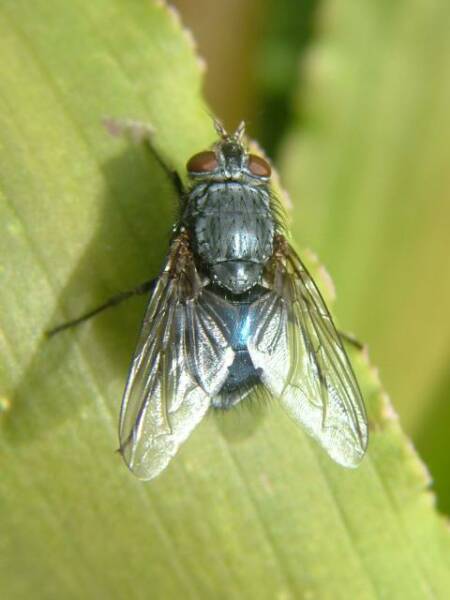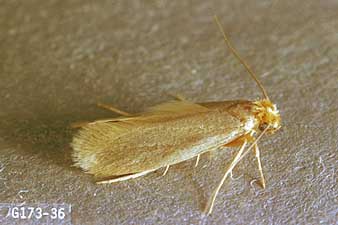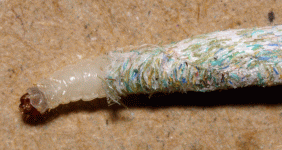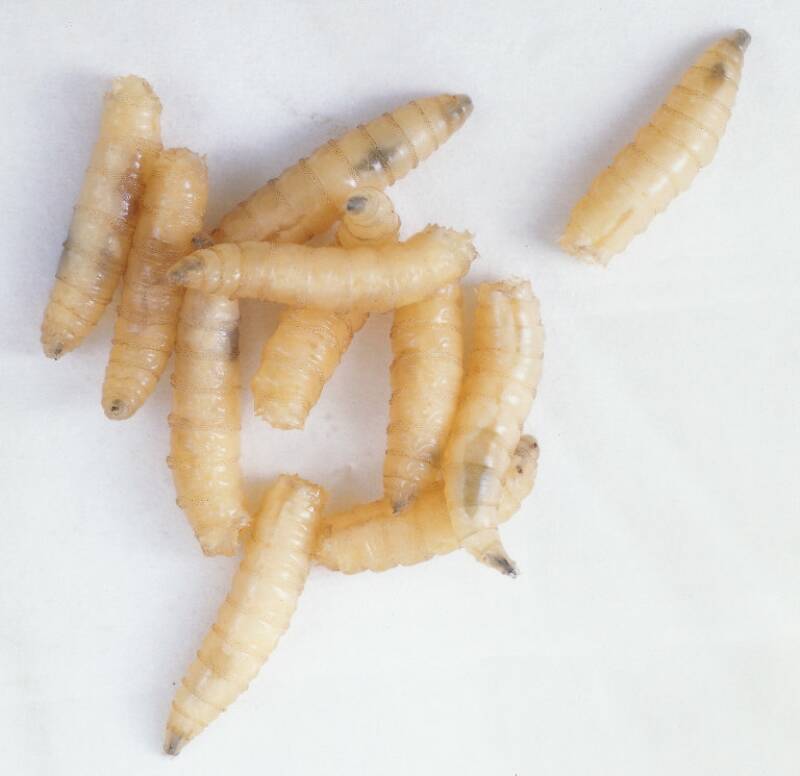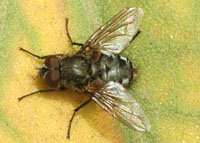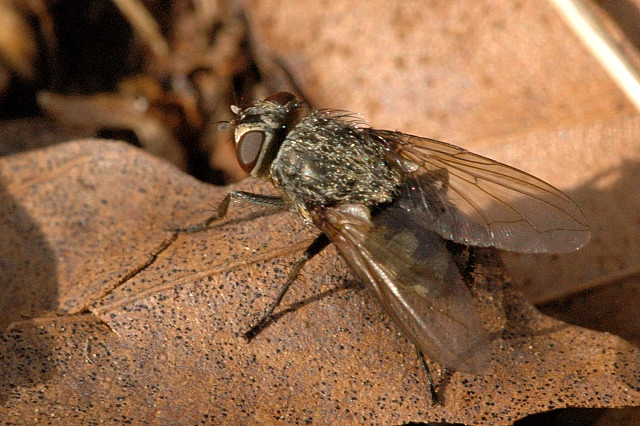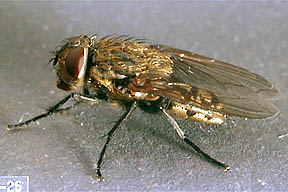Larva in the silken tube.
Flies
The house fly is, perhaps, the most common and widespread animal in the world. It is a serious pest, which spreads many disease-causing pathogens including Salmonella, anthrax and polio. It is greyish in colour with four dark stripes along the back. Like all flies it has one pair of membranous 'true' wings; the second pair of wings are modified into drumstick-like appendages known as 'halteres', which are used in balance. The sponge-like mouthparts are adapted for feeding on liquids, and the reddish compound eyes are large.The housefly has a complete metamorphosis with distinct egg, larva or maggot, pupal and adult stages. The house fly overwinters in either the larval or pupal stage under manure piles or in other protected locations. Warm summer conditions are generally optimum for the development of the house fly, and it can complete its life cycle in as little as seven to ten days, and as many as 10 to 12 generations may occur in one summer. The white eggs, about 1.2 mm in length, are laid singly but pile up in small masses. Each female fly can lay up to 500 eggs in several batches of about 75 to 150 eggs, each over a three to four day period. The number of eggs produced is a function of female size, which is principally a result of larval nutrition.
Control - The presence of this fly is an indicator of a proofing defect and possibly a hygiene problem. Flykillers can be sited to catch insects that have breached barrier methods, but they should not be used as the first line in defence of flies. Insecticidal spray treatment should only be employed to a lighting surfaces, door and window frames but no surface coming into contact with food
Cluster flies (Pollenia rudis)
Cluster flies are found throughout the UK and their common name refers to their habit of forming clusters when “hibernating” - in often large numbers - in buildings.
The life cycle,The female lays eggs in the soil near the burrows of earthworms. The tiny maggots that hatch from the eggs seek out earthworms to feed upon. The maggots of cluster flies have never been reared on any other food but living earthworms. When full grown, the parasitic maggot leaves the body of the host and enters the soil. The Cluster Fly is very much dependent on the prevailing weather conditions, and in this country, two generations a year are usual but in hot summers, up to four generations per year are possible. Cluster flies are “field” flies and in summer and early autumn they are of no consequence. However, as the weather becomes cooler, they seek out shelter in nooks and crannies in houses and other buildings. As the weather becomes colder, they search for more protection from the elements and may be seen in large numbers, particularly in roof spaces, lofts, etc, sometimes with several thousand flies clustered together.
Curiously, it has often been seen that a single house or one building in a row of similar buildings will be chosen year after year for this clustering phenomenon.
Large numbers of cluster flies hibernating together are capable of producing a sickly smell and, if their local environment becomes warmer for any reason, they can emerge to fly around, albeit rather lazily. They are attracted to light which is why they find there way into bedrooms through down lighters etc.
Prevention and Control - Control methods for cluster and swarming flies are often ineffective or incomplete. It is often impossible to keep flies from entering premises. Indeed, it is likely that in many premises used by cluster flies the areas or voids used are difficult, if not impossible, to locate.
The best method of control is to prevent them entering the building in the first place, especially by blocking any access into cavity walls, e.g. replacing missing bricks, filling in other holes, etc. Although proofing is seldom 100% successful, sealing around window and door frames and other obvious entry points can also assist in controlling their presence. Cluster flies do not breed indoors and once they are inside a property, control can be relatively easily achieved with a range of smoke generator insecticides and fly strips.
Moths - The common clothes moth (Tineola bisselliella)
Identification :Size 1mm- 12mm long usually 5mm-7mm and the adult moth is golden brown in colour.
Habitat & Breeding - They sometimes enter buildings via open windows and doors and can originate from birds nests. They are sometimes imported in tapestries, fabrics, soft furnishings and furniture. 40 - 50 laid singly but sometimes they are deposited in ones and twos. Laying takes place in one day but sometimes over period of weeks after which the female moth dies. They are depositied into folds, seams or between fibres. Hatching takes place after 4 to 10 days. The larva is cream white in colour with a golden-brown head and its body sparsely bristled. It lives in an open ended silken tube where it feeds all the time. Sometimes sheets of silk accompany tunnels. Development can be from 35 days to 2.5 years..The pupa is contained within a silken cocoon incorporating frass and fibres.
Control - Spray infested carpet or upholstered furniture with a light mist, to the point of dampness, or dust with an insecticide. The moth and larvae are difficult to control, however a repeated treatment may be necessary to completely eradicate the problem.
Flies and Moths

